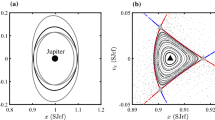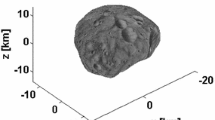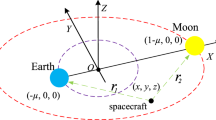Abstract
Quasi-satellite orbits (QSOs) are considered by JAXA’s MMX mission, in which CNES is involved, for the scientific observation of the Martian moon Phobos prior to landing and sample return operations. These periodic orbits, originally defined in the Mars-Phobos circular restricted three-body problem, generically lose periodicity once the eccentricity of Phobos’ orbit is taken into account. In this case, QSOs are replaced by quasi-periodic tori. Recent work on MMX project includes, among many others, station-keeping strategies around QSOs exploiting invariant tori in the elliptic Hill problem. In the present paper, a resonant QSO will be first computed in the Mars-Phobos circular restricted three-body problem. Then, by continuation on the eccentricity of the secondary, this QSO will be converted into a periodic resonant QSO in the Mars-Phobos elliptic restricted three-body problem. The latter problem is more precise than the Hill problem at far distance from the secondary and thus more adapted to handle Mars-Phobos transfers. Notice that considering resonant orbits enables to preserve the periodicity of the QSOs when the eccentricity is nonzero. Then, a family of invariant tori surrounding the resonant QSO in the Elliptic Restricted Three-Body Problem will be obtained by continuation on the frequency. In the next step, stable invariant manifolds emanating from the tori will be computed. Finally, two-impulse transfers between a parking orbit around Mars and the tori surrounding the QSO will be presented with the objective to minimize the total velocity increment. Interesting transfer trajectories will be shown allowing for a ballistic approach to Phobos. These trajectories lead to a reduction in the total velocity increment in comparison with classical Mars to QSOs transfers. Here, instead of targeting directly the resonant QSO, the spacecraft will reach first an invariant manifold before coasting along this manifold until encountering a torus surrounding the QSO. Thus, the spacecraft will reach a quasi-periodic QSO inside the torus that is close to the periodic resonant QSO.










Similar content being viewed by others
Notes
In this work, the only frame that is considered is the synodic frame.
In fact, there is a more subtle classification of the orbits of family f, see (Pousse et al. 2016). In the interest of simplification, this classification will not be considered in this paper.
References
Alessi, E.M., Gómez, G., Masdemont, J.: Two-manoeuvres transfers between leos and lissajous orbits in the earth-moon system. Adv. Space Res. 45(10), 1276–1291 (2010)
Allgower, E., Georg, K.: Simplicial and continuation methods for approximating fixed points and solutions to systems of equations. SIAM Rev. 22(1), 28–85 (1980)
Arnold, V.I.: Proof of A.N. Kolmogorov’s theorem on the preservation of quasi-periodic motions under small perturbations of the Hamiltonian. Russian Math. Surveys 18(5), 9–36 (1963)
Arnold, V.I.: Mathematical Methods of Classical Mechanics. Springer, New York (1978)
Baresi, N., Dei Tos, D. A., Ikeda, H., Kawakatsu, Y.: Orbit design and maintenance in the Elliptical Hill Problem with applications to the Phobos sample return mission MMX, Paper IAC-19.C1.4.7. In: 70th International Astronautical Congress, Washington D.C., USA, 21–25 (2019)
Benest, D.: Libration effects for Retrograde Satellites in the Restricted Three-Body Problem I: Circular plane Hill’s case. Celest. Mech. 13, 203–215 (1976)
Broucke, R.A.: Periodic Orbits in the Restricted Three-body Problem with Earth-Moon Masses. JPL technical report. Jet Propulsion Laboratory, California Institute of Technology (1968)
Canalias, E., Lorda, L., Laurent-Varin, J.: Design of realistic trajectories for the exploration of Phobos. In: AIAA Space Flight Mechanics Meeting, Kissimmee, USA, 8-12 (2018)
Chen, H., Canalias, E., Hestroffer, D., Hou, X.: Stability analysis of three-dimensional Quasi-Satellite orbits around Phobos. In: 69th International Astronautical Congress, Bremen, Germany, 1–5 (2018)
Chirikov, B.V.: A universal instability of many-dimensional oscillator systems. Phys. Rep. 52(5), 263–379 (1979)
Darwin, G.H.: Periodic orbits. Acta Math. 21, 99–242 (1897)
de la Llave, R., González, A., Jorba, À., Villanueva, J.: KAM theory without action-angle variables. Nonlinearity 18(2), 855–895 (2005)
Douskos, C., Kalantonis, V., Markellos, P.: Effects of resonances on the stability of retrograde satellites. Astrophys. Space Sci. 310, 245–249 (2007)
Floquet, G.: Sur les équations différentielles linéaires à coefficients périodiques. Annales Scientifiques De L Ecole Normale Superieure 12, 47–88 (1883)
Hénon, M.: Numerical exploration of the restricted three-body problem. In: Kontopoulos, G.I. (ed.) The Theory of Orbits in the Solar System and in Stellar Systems, IAU Symposium, vol. 25, pp. 157 (1966)
Hénon, M.: Numerical study of quadratic area-preserving mappings. Q. Appl. Math. 27(3), 291–312 (1969a)
Hénon, M.: Numerical exploration of the restricted problem, V. Hill’s Case: Periodic orbits and their stability. Astron. and Astrophys. 1, 223–238 (1969b)
Hénon, M.: Numerical exploration of the restricted problem. VI. Hill’s case: Non-periodic orbits. Astron. and Astrophys. 9, 24–36 (1970)
Hénon, M., Guyot, M.: Stability of periodic orbits in the restricted problem. In: Giacaglia, G.E.O. (ed.) Periodic Orbits, Stability and Resonances, pp. 349–374. Springer, Dordrecht (1970)
Jackson, J.: Retrograde satellite orbits. Mon. Not. R. Astron. Soc. 74(2), 62–82 (1913)
Jorba, À.: Numerical computation of the normal behaviour of invariant curves of \(n\)-dimensional maps. Nonlinearity 14(5), 943–976 (2001)
Jorba, À., Simó, C.: On the reducibility of linear differential equations with quasiperiodic coefficients. J. Differ. Equ. 98, 111–124 (1992)
Jorba, À., Villanueva, J.: On the persistence of lower dimensional invariant tori under quasi-periodic perturbations. J. Nonlinear Sci. 7, 427–473 (1997)
Kolmogorov, A.N.: On the persistence of conditionally periodic motions under a small change of the Hamilton function. Dokl. Akad. Nauk, Ross. Akad. Nauk 98(4), 527–530 (1954)
Lam, T., Whiffen, G.J.: Exploration of distant retrograde orbits around Europa. Adv. Astronaut. Sci. 120, 135–153 (2005)
Markellos, V.: Numerical investigation of the planar restricted three-body problem. I. Periodic orbits of the second generation in the Sun-Jupiter system. Celestial Mech., 9, 365–380 (1974)
Moser, J.: On invariant curves of area-preserving mappings of an annulus. Nachr. Akad. Wiss. Göttingen Math.-Phys. Kl. II 2, 1–20 (1962)
Ogawa, N., Tsuda, Y., Takei, Y., Inoue, H., Takahashi, S., Kawakatsu, Y.: Orbit design for martian moons explorer. In: 26th International Symposium on Space Flight Dynamics, Matsuyama, Japan, 3–9 (2017)
Oshima, K., Yanao, T.: Spatial unstable periodic quasi-satellite orbits and their applications to spacecraft trajectories. Celestial Mech. Dyn. Astron. 131(23), 1–32 (2019)
Pousse, A., Robutel, P., Vienne, A.: On the co-orbital motion in the planar restricted three-body problem: the quasi-satellite motion revisited. Celest. Mech. Dyn. Astron. 03 (2016)
Sidorenko, V., Neishtadt, A., Artemyev, A., Zelenyi, L.: Quasi-satellite orbits in the general context of dynamics in the 1:1 mean motion resonance: perturbative treatment. Celest. Mech. Dyn. Astron. 120, 10 (2014)
Strömgren, E.: Connaissance actuelle des orbites dans le problème des trois corps. Bull. Astron. 90, 87–130 (1935)
Szebehely, V.: Theory of Orbits. Academic Press, Cambridge (1967)
van der Weele, J.P., Capel, H.W., Valkering, T.P., Post, T.: The squeeze effect in non-integrable Hamiltonian systems. Phys. A 147(3), 499–532 (1988)
Wiesel, W.: Stable orbits about the Martian moons. J. Guid. Control Dyn. 16, 434–440 (1993)
Wiggins, S.: Introduction to applied nonlinear dynamical systems and chaos. Comput. Phys. 4(5), 563 (2003)
Winter, O., Neto, E.: Time analysis for temporary gravitational capture. Stable orbits. Celest. Mech. Astrom. 377(3), 1119–1127 (2001)
Acknowledgements
The authors thank Dr. Elisabet Canalias for helpful discussions and suggestions and to the reviewers for their corrections.
Author information
Authors and Affiliations
Corresponding author
Additional information
Publisher's Note
Springer Nature remains neutral with regard to jurisdictional claims in published maps and institutional affiliations.
Rights and permissions
About this article
Cite this article
Jorba-Cuscó, M., Epenoy, R. Low-fuel transfers from Mars to quasi-satellite orbits around Phobos exploiting manifolds of tori. Celest Mech Dyn Astr 133, 20 (2021). https://doi.org/10.1007/s10569-021-10017-9
Received:
Revised:
Accepted:
Published:
DOI: https://doi.org/10.1007/s10569-021-10017-9
Keywords
- Mars-Phobos transfers
- Elliptic restricted three-body problem
- Quasi-periodic quasi-satellite orbits
- Manifolds of tori




